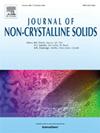Evolution of activation energy for boron dissolution in the borosilicate glass during the initial leaching stage
IF 3.2
3区 材料科学
Q1 MATERIALS SCIENCE, CERAMICS
引用次数: 0
Abstract
Borosilicate glass is widely used for immobilizing high-level radioactive waste. In this study, two types of borosilicate glasses, Na-borosilicate and Zr-Na-borosilicate, were subjected to leaching within a temperature range of 50–90 °C, at 10 °C intervals. The rate of boron consumption was measured by Inductively Coupled Plasma Optical Emission Spectrometer (ICP-OES) and Fourier-Transform infrared spectroscopy (FTIR) techniques, and the boron activation energy was determined through the Arrhenius equation. The boron activation energies for Na-borosilicate and Zr-Na-borosilicate glasses are approximately 46 kJ/mol and 42 kJ/mol, respectively. The activation energy, which FTIR calculated, was consistent with that obtained by ICP-OES during the initial leaching time and decreased as the leaching time increased. The decrease in activation energy of boron is because the [BO3] structure was replaced by molecular water. The FTIR method offers an alternative approach for calculating the boron activation energy and contributes to understanding the leaching mechanism in the initial leaching stage.
硼硅酸盐玻璃中硼溶解活化能在初始浸出阶段的变化
硼硅酸盐玻璃被广泛用于固定高放射性废物。在这项研究中,两种类型的硼硅酸盐玻璃(Na-硼硅酸盐和 Zr-Na 硼硅酸盐)在 50-90 °C 的温度范围内,以 10 °C 的间隔进行浸出。通过电感耦合等离子体光学发射光谱(ICP-OES)和傅立叶变换红外光谱(FTIR)技术测量了硼的消耗速率,并通过阿伦尼乌斯方程确定了硼的活化能。Na 硼硅酸盐玻璃和 Zr-Na 硼硅酸盐玻璃的硼活化能分别约为 46 kJ/mol 和 42 kJ/mol。傅立叶变换红外光谱仪计算出的活化能与 ICP-OES 在初始浸出时间获得的活化能一致,并随着浸出时间的延长而降低。硼活化能的降低是因为[BO3]结构被分子水所取代。傅立叶变换红外光谱法为计算硼活化能提供了另一种方法,有助于了解初始浸出阶段的浸出机制。
本文章由计算机程序翻译,如有差异,请以英文原文为准。
求助全文
约1分钟内获得全文
求助全文
来源期刊

Journal of Non-crystalline Solids
工程技术-材料科学:硅酸盐
CiteScore
6.50
自引率
11.40%
发文量
576
审稿时长
35 days
期刊介绍:
The Journal of Non-Crystalline Solids publishes review articles, research papers, and Letters to the Editor on amorphous and glassy materials, including inorganic, organic, polymeric, hybrid and metallic systems. Papers on partially glassy materials, such as glass-ceramics and glass-matrix composites, and papers involving the liquid state are also included in so far as the properties of the liquid are relevant for the formation of the solid.
In all cases the papers must demonstrate both novelty and importance to the field, by way of significant advances in understanding or application of non-crystalline solids; in the case of Letters, a compelling case must also be made for expedited handling.
 求助内容:
求助内容: 应助结果提醒方式:
应助结果提醒方式:


